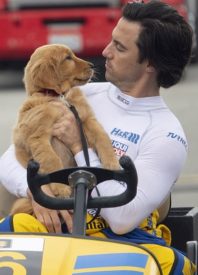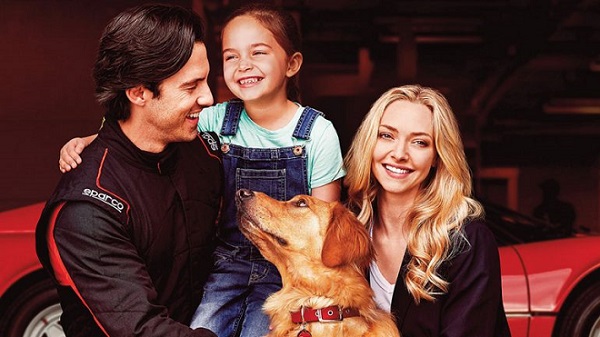
There is a long history of dogs in cinema. However, from the Italian Nerorealist classic Umberto D. to the Tim Allen led gag stocking stuffer The Shaggy Dog, this long history varies in quality. Unfortunately, Simon Curtis’ new feature The Art of Racing in the Rain ultimately falls closer to the Tim Allen end of the spectrum than the De Sica one.
The Art of Racing in the Rain, adapted from a novel of the same name, focuses on the life of Denny Swift (Milo Ventimiglia), a low-level race car driver grinding away at the sport’s minor leagues, while hoping for his big break. This story, however, is refracted through the lens of Denny’s dog Enzo (voice of Kevin Costner) who perpetually narrates the film’s events. Denny teaches Enzo some of the basic principles of racing through late nights spent watching television together, and the two have an unspeakable bond. Along the way Enzo witnesses Denny fall in love with Eve (Amanda Seyfried), and he must help Denny make it through innumerable trials and tribulations.
Every decision a film makes ultimately has consequences, intended or otherwise. This is one of the inherent realities of cinema, and it is largely why perfect films are, for the most part, non-existent. Theoretically, even if you exclusively make good choices, by making a choice you lose the opportunity to make a different one. Choosing choice “X”, and not choice “Y”, means you cannot get the results of both choices. It also does not mean you only get the results of choice “X.” By choosing “X,” you are also saddled with the consequence of losing the opportunity to choose “Y.” Good films are aware of this inherent conundrum. They weaponize the choices they make towards varying forms of meaning.
The “X” choice in The Art of Racing in the Rain is to emphasize the story through Enzo’s narration. The desired output behind such a choice, is that audience’s will mentally connect him with their own pets at home. Most pet owners have a running narration of what their pet is thinking and feeling, and theoretically, Enzo should be the metaphorical manifestation of such a habitual behaviour. The consequence of this choice, however, is that it makes the revelations feel glib. The rough theme of the Art of Racing in the Rain is that we must deal with life as it comes, however, this theme (which is randomly revealed deliriously deep into the first act) seems tacked on at best. Curtis’ film actually has little to say about the world around it, aside from the real message of “dogs are special creatures that will impact our lives forever.”
This simplistic message isn’t necessarily a negative, but it becomes a crutch for a film that struggles with providing depth and nuance. The film must simplify the world so that Enzo can understand it, and it will make sense in the context of a dog’s eyes. This results in poor character development. Antagonists are designated as such through offhand remarks made about Enzo’s laziness. The diegesis becomes cloying, one-dimensional, and rote. In one instance, a critical moral dilemma faced by a character merely becomes a footnote to Enzo’s heroism. Character motivations become fleeting at best. At one point, a character abandons Enzo in the house for several days, without making any arrangements for him. No motivation is provided outside of maybe that said character is sick, which only serves to make such a decision feel increasingly random and unrealistic. Because so much of the film runs through Enzo’s narration, the capacity for the humans to be more than simple caricatures is minimized.
The character development might be more successful if the actual written narration were better. Enzo is the dog version of the pseudo-profound observational philosopher that you strike up a conversation with at the bar, listen to for a bit, and then afterwards ponder if they were really saying anything meaningful. One example is how the film makes painstaking efforts to assure us that he is very smart, but this only sets up the usual animal-based gags to spectacularly fail. Is there at least one fecal based gag in The Art of Racing in the Rain? If you have to ask the question, you already know the answer. Furthermore, there are perpetual racing metaphors in Curtis’ film, but they fail to add up to anything outside of a simplistic point about life’s lack of predictability.
Costner’s voice performance just about saves this film. His deep baritone cadences contribute heavily to the feeling that the narration has a profundity it actually lacks, but the trick is convincing enough to probably work if you don’t think about what the words are actually saying. Seyfried gives easily the next best performance, although it matches her usual rendition of a human ball of sunshine. Ventimiglia’s cult fanbase will revel in his usual brooding, working-class, strong silent type turn, but much like Seyfreid it has little to distinguish it from being another rendition on Jess from Gilmore Girls. Gary Cole is severely under utilized as Denny’s professional mentor.
I am certain that The Art of Racing in the Rain will bring tears to many a dog owner’s eyes. They will come home, assure their canine friend they love them, and maybe even show that love in the form of a treat. I am much less certain that this film will fail to instantaneously dissipate from their minds the second the above sequence of steps is completed. My suggestion: take them for a long walk instead. You’re more likely to make lasting memories that will have an impact.
- Release Date: 8/8/2019


